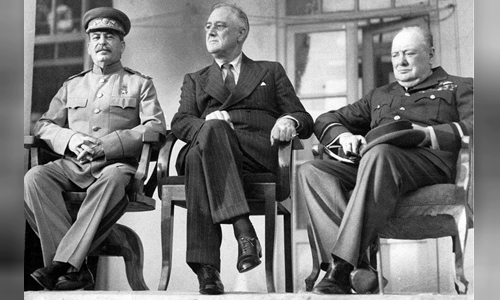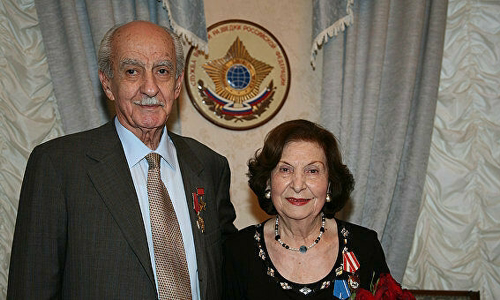Vartanian and his wife promptly discovered a group of German officers sent to Iran to assassinate the three Allied leaders in 1943.
The Russian Overseas Intelligence Service (SVR) said on November 26 that the former spy agent Goar Vartanian had died the day before at the age of 93 and would be buried at Troyekurovskoe cemetery in Moscow.

Soviet leader Stanlin (left), US President Roosevelt (center) and British Prime Minister Churchill met in Tehran in late November 1943 Photo: WarfareHistoryNetwork.
SVR praised her and her husband Gevork Vartanian as a pair of "legendary spies" of the Soviet Union with the most outstanding achievement of smashing the campaign "Long Jump" (Long Jump), a Nazi plot to haunt killed allied leaders during their first meeting in Tehran in November 1943.
According to historians, the Long Jump was probably the most daring plan of Nazi Germany and could have the most serious consequences during World War II if it were not stopped by Vartanian couple and Soviet agents in time. .
In October 1943, German military intelligence deciphered the code of the US Navy and discovered that an important conference of three key Allied leaders including Soviet Marshal Joseph Stalin and British Prime Minister Winston Churchill and US President Franklin Roosevelt will be held in Tehran, the capital of Iran in November of that year.
The three Allied leaders then wanted to gather to come up with a final strategy for the war against Nazi Germany and the Axis. Stanlin also wants to know how Britain and the US will open a second front in Western Europe. The meeting was scheduled to be held at the Soviet embassy in Tehran from November 28 to December 1, 1943.
Based on intelligence obtained, German fascist Adolf Hitler approved Operation Rösselsprung, or the Long Jump, with the goal of assassinating or kidnapping the three pillar leaders of the Allies (also known as the group Big Three).
Otto Skorzeny, lieutenant colonel of the notorious German SS force, who carried out the rescue campaign of the dictator of Italy Benito Mussolini in September 1943, was selected as the commander of the Long Jump. Agent Elyesa Bazna (alias Cicero) operating in Ankara, Turkey was also mobilized to join the campaign.
However, Soviet intelligence was able to grasp this bold assassination plot thanks to intelligence officer Nikolai Kuznetsov, who infiltrated the Nazi ranks in Ukraine under the guise of Lieutenant Paul Siebert. Kuznetsov sought to get along with Ulrich von Ortel, a commanding officer in the SS.
Kuznetsov constantly deprived Ortel of alcohol, prompting him to talk about his plan to assassinate the Big Three leadership group in Tehran, where "we will destroy Stalin and Churchill and change the course of the battle!"
"We will kidnap Roosevelt to help the Führer defeat the United States. We will fly in many groups. Our men are being trained at a special school in Copenhagen," Ortel bragged while drunk, even He even promised to introduce Kuznetsov to Lieutenant Colonel Skorzeny.
By this time, Soviet intelligence had to rely on agents operating in Iran, including the Vartanian couple and five other members of the counterintelligence group in the country.
Gevork Vartanian was born in 1924, to an Armenian Iranian family in the city of Rostov-on-Don, in southern Russia. His father was a Soviet spy and was sent to Iran in 1930, where he lived with his family and intelligence under the guise of a wealthy businessman. At the age of 16, Gevork succeeded his father, becoming a Soviet spy under the alias Amir, with the main task of hunting British and German spies.
Goar was born in 1926 in Gyumri, part of the former Soviet Union, and followed her family to Iran in the early 1930s. She joined the anti-fascist group when she was 16 and cooperated with Gevork Vartanian to detect agents. Virtue. The couple then got married, when Gevork was 19, and Goar was 17.
Gevork and Goar's spy team uncovered about 400 German spies in Iran between 1940-1941. Gevork even registered a spy training program for British intelligence in Tehran, and then reported all information to the Soviet intelligence service. As a result, Russian-speaking agents in Britain sent to the Soviet Union during World War II were either arrested, or recruited as double agents for the Soviet Union.

Veteran spouses Gevorg (right) and Goar (left) in 2010 Photo: TASS
After receiving information from Kuznetsov about the Long Jump, Soviet intelligence requested that the Vartanian group be on high alert, and it was the spies themselves who were the first to discover the German front line in the war. Translate.
"We were the first unit to locate the first Nazi assassination group, which included six liaison officers, parachuting down to the town of Qum, 60 kilometers from Tehran. We followed them to Tehran." , where the Nazis prepared a mansion for the group to hide in. They traveled by camels and were armed, "Gevorg Vartanian later recalled.
Gevorg recounted that as six Nazi agents approached Tehran, a truck appeared and loaded their equipment, including radios, weapons, and explosives. They moved to a safe haven in Tehran, set up communication equipment, changed into civilian clothes and dyed their hair to disguise.
"When we were monitoring the assassin group, we knew that they contacted Berlin by radio, so we intercepted their communications. After breaking the code, we learned that Germany was The commune is preparing to send the second group to execute the plan to assassinate or kidnap the Big Three ", he said.
The second group is said to be directly led by Skorzeny. Lieutenant Colonel Skorzeny then went to Tehran to investigate the situation and Gevorg's team had been monitoring his activities ever since.
When Roosevelt accompanied the American delegation to Tehran, the Soviet side revealed to them the Nazi assassination plan. In order to minimize Roosevelt's danger of moving from the US embassy to the meeting place in Tehran, the US President and the delegation were allowed to stay in the guesthouse in the Soviet embassy.
During that time, the Vartanian's group captured and controlled all six spies in the German front line, forcing them to continue contacting the headquarters under Soviet surveillance.
"The capture of Skorzeny was fascinating, but the Big Three arrived in Tehran so we could not take the risk. We purposely gave the Nazi liaison a chance to announce that the mission had failed," and they decided not to bring the second group to Tehran, "Gevorg said.
The Vartanian's group accurately pinpointed the location of the parachute outpost and their subsequent activities halted one of the greatest assassination plots in World War II. The couple's love story later became the inspiration for building the characters Andrei and Marie in the Soviet detective action movie "Tehran 43".
The Vartanians moved to the Soviet Union in 1951 and continued their intelligence operations for a long time. The identity of Gevorg, who was named the "Soviet Hero", was only officially announced in 2000. "We were very fortunate not to meet any traitors," he once told. RIA Novosti. "For undercover agents like us, betraying is the worst crime."
Gevorg died in 2012 at the age of 87. "Gevork has often said that at least two of the five rays in his Hero Star belong to his beloved Goar wife," the SVR spokesman said.
In June 2017, Russian President Vladimir Putin visited the SVR and praised secret agents, including the Vartanian couple. "They are humble people, they don't like to be called heroes," Putin said.



 MerlysFrancis
MerlysFrancis







